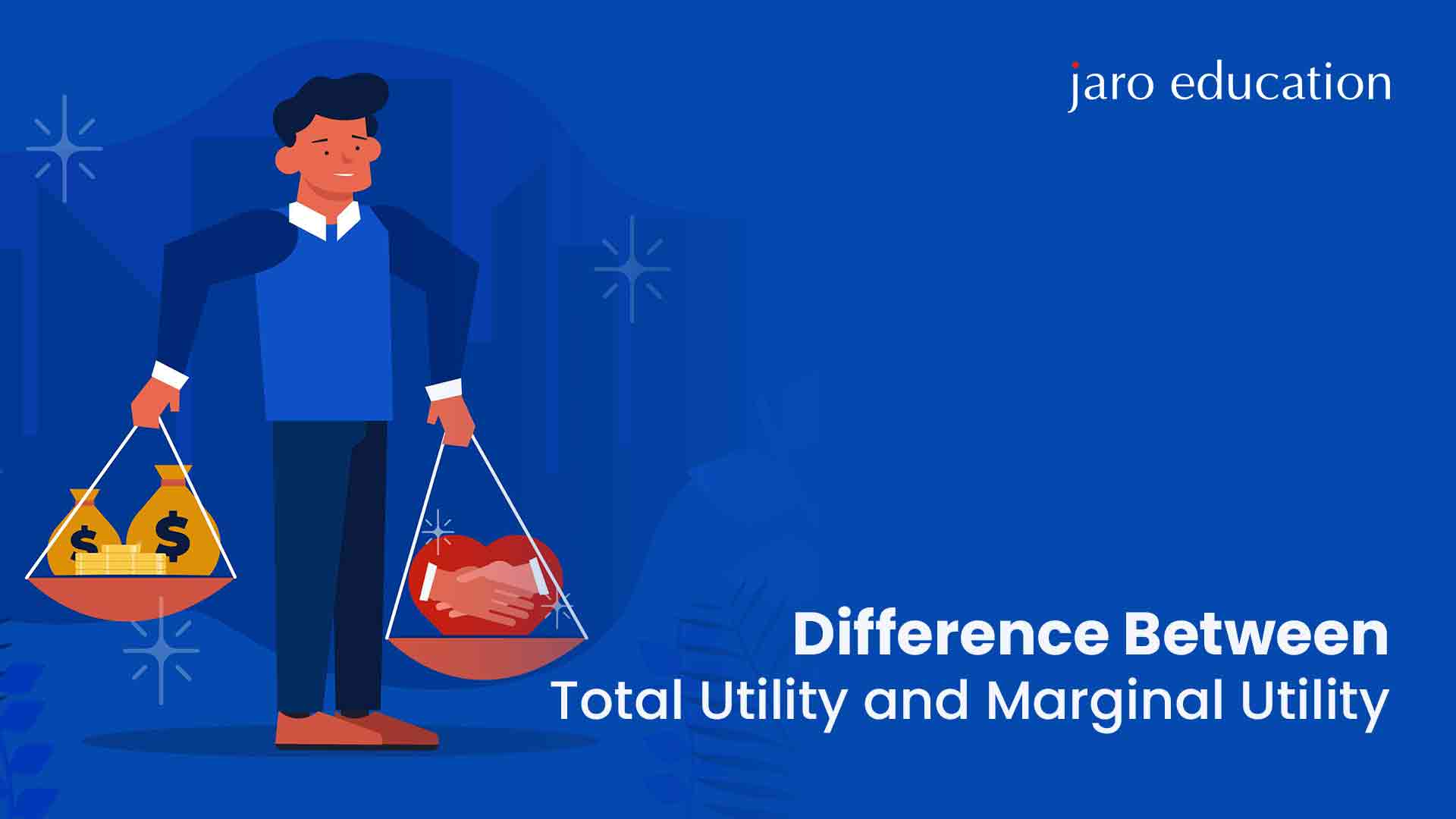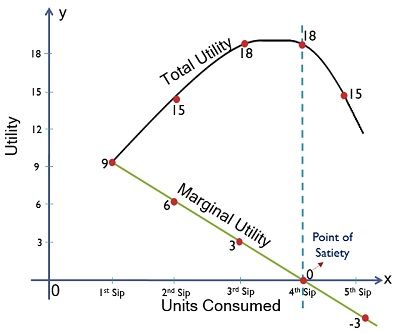The Difference Between Total Utility and Marginal Utility
Table of Contents

- jaro education
- 7, May 2024
- 6:10 pm
The concepts of total utility and marginal utility stand as fundamental pillars shaping our understanding of consumer behaviour and decision-making. As consumers, we constantly weigh the satisfaction derived from consuming goods and services against their costs. However, within this framework, it’s essential to understand total utility and marginal utility, as they offer distinct insights into how our preferences evolve with each additional unit consumed.
For example, books satisfy our thirst for knowledge, bread satisfies our hunger and so on. In the field of economics, it is known as consumer theory.
But before delving into these two pivotal topics, let’s discuss the characteristics of Utility in general.
Characteristics of Utility
- Utility is subjective – It varies from person to person’s assessment of the amount of satisfaction they get from a product.
- Utility can’t be measurable– Since utility depends on subjects, it can’t be assessed objectively.
- Utility is relative– It is not absolute. The need for that item determines the usefulness of an item. The higher the need, the higher the utility. Due to this, utility varies from person to person, from place to place, and from time to time.
- Utility and usefulness are not synonymous. When an item has utility, it doesn’t mean it has usefulness. A useless item can have higher utility. For example, smoking is injurious to health, yet its utility is higher as it satisfies the needs of a smoker.
- We can not judge utility in ethical, moral or legal aspects.
Introduction to Total Utility and Marginal Utility
Total utility and marginal utility are two important concepts in Economics. To calculate the total satisfaction, total utility is used, whereas to find the total addition or subtraction in the total utility, marginal utility is used.
Defining Total Utility
Imagine having a bite of your favourite food when you are famished. The first bite contributes to a certain sense of satisfaction, which is called total utility. Total Utility represents the general satisfaction a person derives from consuming a particular good or service. It is the collective happiness that a person gets after having those items.
Here are Some Key Characteristics of Total Utility
- Subjective: The satisfaction you get from consuming any product is subjective. What brings you great joy can be disturbing to others.
- Measured in Utils: Due to the concept of Total Utility being subjective, economists use a hypothetical unit called ‘Util’ to measure units of satisfaction. But it’s important to remember that ‘utils’ are not a real unit of measurement; they can’t be compared to people directly.
- A Non-negative Value: Total Utility is always considered as a Non-negative Value. Even if there is zero utility, it will not bring dissatisfaction or negative utility.
- Diminishing Marginal Utility: The law of diminishing marginal utility states that the more you consume a good or service, the less satisfied you will be with each additional unit consumed or used. Let’s go back to the example of a bite of your favourite food. The exhilaration of the first bite won’t be there in the second bite. With every additional bite, the satisfaction curve might go flat and even decline.
Defining Marginal Utility
Marginal utility can be defined as the addition or subtraction of total utility from any particular good or service consumption. It can come from a particular person or group. It shows the graph of satisfaction a consumer derives from any form of commodity, which varies from person to person.
Let’s delve into the characteristics of Marginal Utility in short.
- Focused on incremental benefit: Unlike total utility, marginal utility strictly reflects incremental benefit. Acting rationally, consumers maximise their total utility with limited assets, and marginal utility helps them make accurate decisions. Every single unit of consumption sheds light on measuring total utility.
- It has Positive, Zero or Negative Value: The additional satisfaction that comes from consuming one more unit that can be considered Positive. Zero value is when there are no changes in satisfaction, or Negative value is when the satisfaction is decreased. Let’s think of the example of your favourite food when you are hungry; with the first bite comes satisfaction. After a few more bites, you will feel no change in your satisfaction, but when you are full yet still taking forceful bites, it decreases the satisfaction.
- Scarcity determines Utility: When there is a shortage of good consumer things, the initial units provide more satisfaction than in a normal scenario. Imagine finding a piece of bread when you are deprived of food.
Relationship Between Total Utility and Marginal Utility
From the points that we have already covered, we can see an intricate relationship between total utility and marginal utility. Though there is a difference in their specific meaning, both are integral to understanding customer behaviour and preferences. With the help of this concept, we can derive these conclusions:
- Marginal Utility goes on decreasing as the consumer consumes more and more units. At the same time, the total utility increases slowly as the marginal utility rate diminishes.
- When marginal utility is zero, total utility is the maximum. And it’s the point of most satisfaction.
- When consumption rises beyond the point of satisfaction, then the marginal utility becomes negative and total utility starts falling.
In essence, total utility reflects the total satisfaction from consuming an amount of quantity, whereas marginal utility indicates additional satisfaction from consuming another unit. They work together to explain the decline in returns we get as we consume more goods.
Difference Between Total Utility and Marginal Utility
The following points will help the readers understand the significant differences between total utility and marginal utility.

*theinvestorsbook.com
- The total utility is the total satisfaction a consumer derives from consuming any particular product. Meanwhile, marginal utility is the amount of satisfaction a consumer derives by additional consumption of the same product.
- The total utility rises as more and more of a commodity is consumed. In contrast, the marginal utility of a product decreases with each additional unit consumed.
- When the customer no longer derives satisfaction from the consumption of the goods, the utility of that product reaches a point of saturation. Unlike in marginal utility, the utility of that product decreases with each unit consumed of a product; total utility increases with each additional unit of the product consumed.
How Total Utility and Marginal Utility Affect Consumer Decisions?
The concepts of total utility and marginal utility help us understand the rational behaviour of consumers. Consumers want to maximise their total utility with their limited budget. Here’s how:
Satisfaction of the Consumers:
Consumers will continue consuming goods or products as long as they are satisfied. This means the marginal utility of the last unit consumed is equal to or greater than the price they have paid for that particular product. This is the point where the customer’s satisfaction is balanced out by the last unit of that particular product they have consumed.
The demand of law:
As the price of a commodity increases, consumers will lose interest in that commodity. Because the marginal utility derived from each commodity becomes equal or less valuable compared to the price they have paid.
Applications of Total Utility and Marginal Utility
Understanding the nature of total utility and marginal utility is important for various reasons:
- Marketing: To understand consumers’ demands, design pricing strategies, and identify the target consumer businesses that are using these concepts.
- Behaviour analysis of the consumers: Businesses can predict consumer choices and optimise their products by analysing how marginal utility works.
- Public Policy: To design taxation, regulations of consumer welfare are decided by the public policymakers utilising the concept of total and marginal utility.
Limitations of Total Utility and Marginal Utility
While total and marginal utility can be used abundantly, there are certain limitations that can’t be overlooked:
- Subjective – It is one of the drawbacks of Total and Marginal utility. What is interesting to one person may not be the same for the other.
- Non-quantifiable – Utility cannot be measured by objective units. It’s a personal feeling that can be measured only by a hypothetical unit.
- Rationally not derived – Utility models usually assume the preferences of a specific group. However, that may not be acceptable in other real-life scenarios.
Conclusion
Total utility and marginal utility are fundamental concepts in comprehending consumer behaviour. The above concepts are largely used in economics and business studies as they calculate the satisfaction gained by the customer from any product. Total Utility projects a bigger picture of overall satisfaction, whereas Marginal Utility strictly focuses on the gradual benefit derived from each additional unit. By having a proper knowledge of these interlaced concepts, comprehending individual conceptions as well as broader economic trends is possible.
If you want to learn more about total and marginal utility and be relevant in this particular industry, you can start your journey by opting for an Online Bachelor of Business Administration by Chandigarh University. This programme is taught by the best academicians and industry experts, providingaccess to job portals with 300+ hiring partners and much more. So, why wait? Scale up your professional growth at a global level and get ready to master industry relevant skills.










